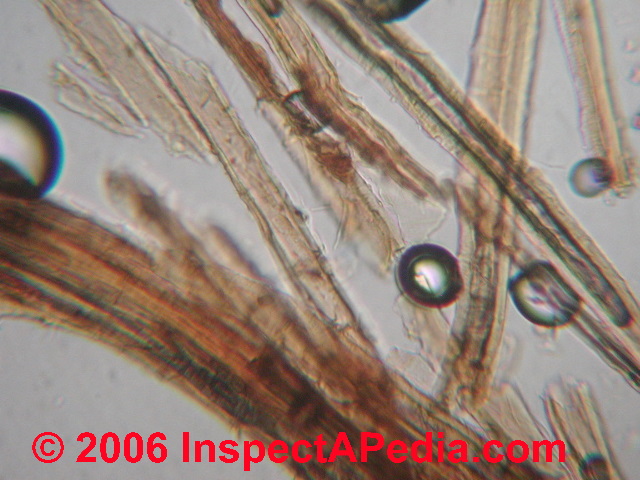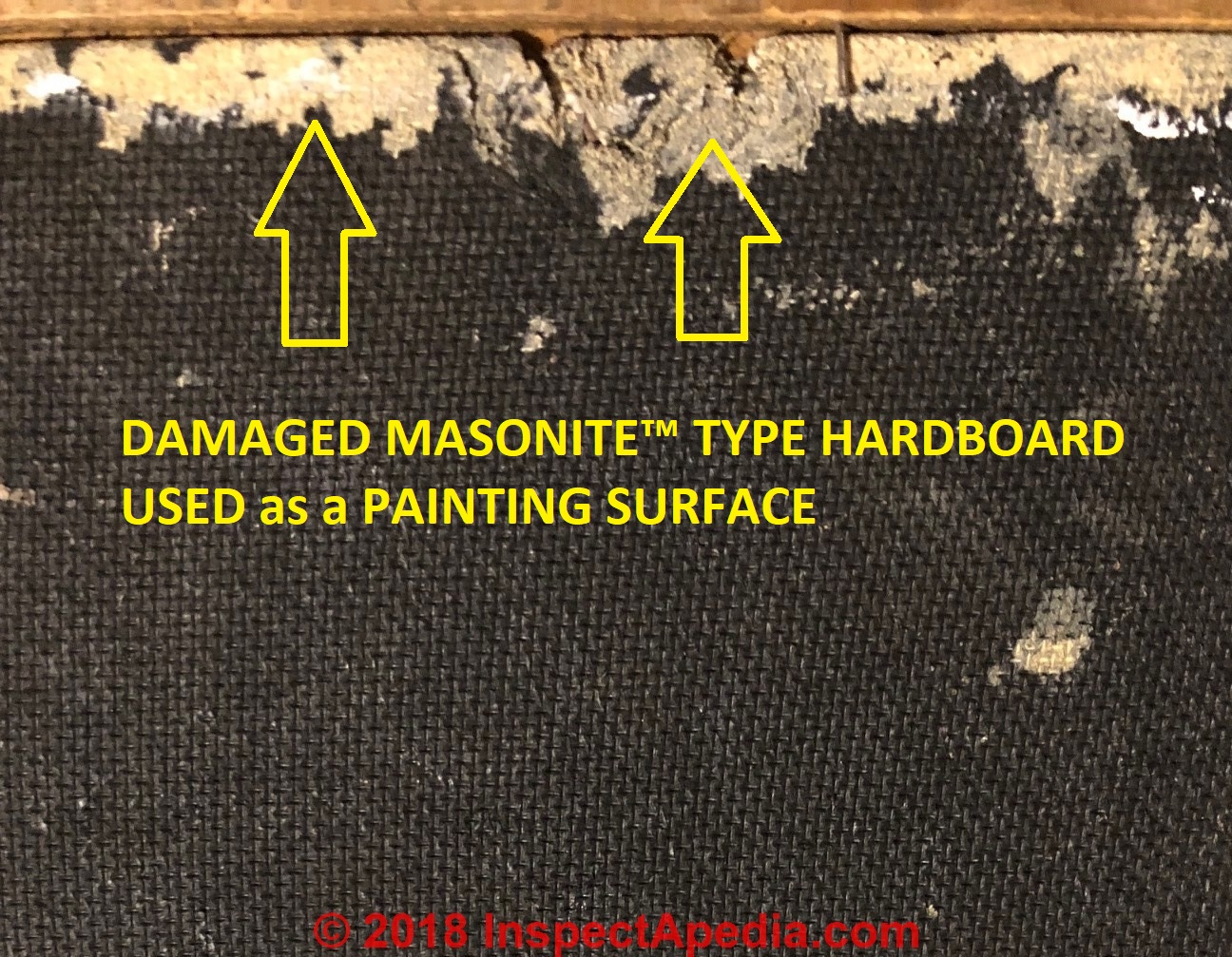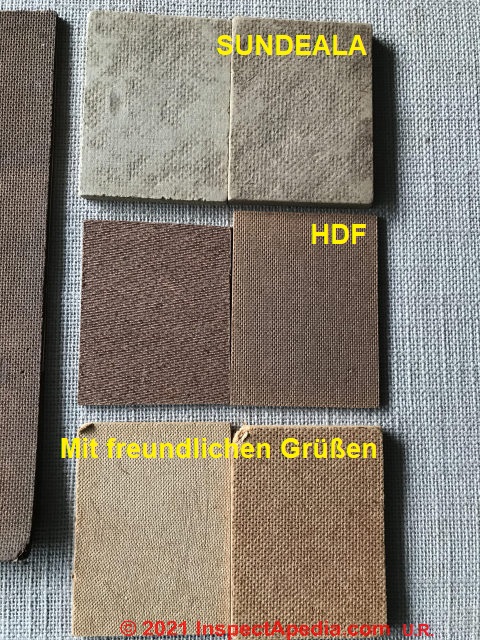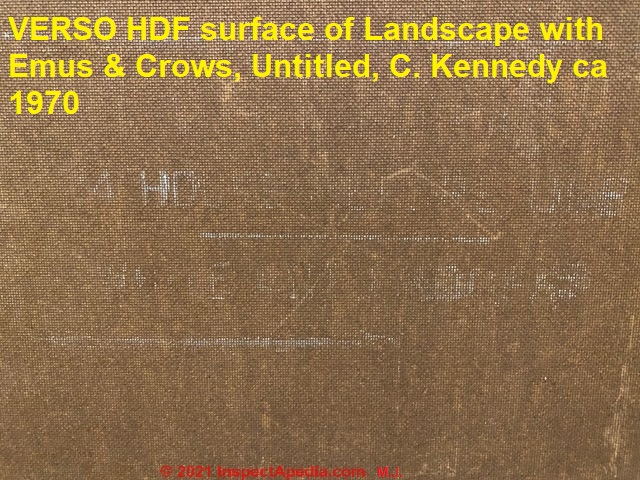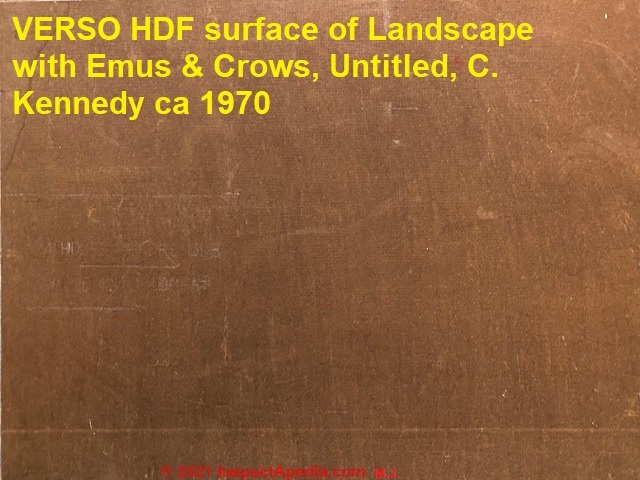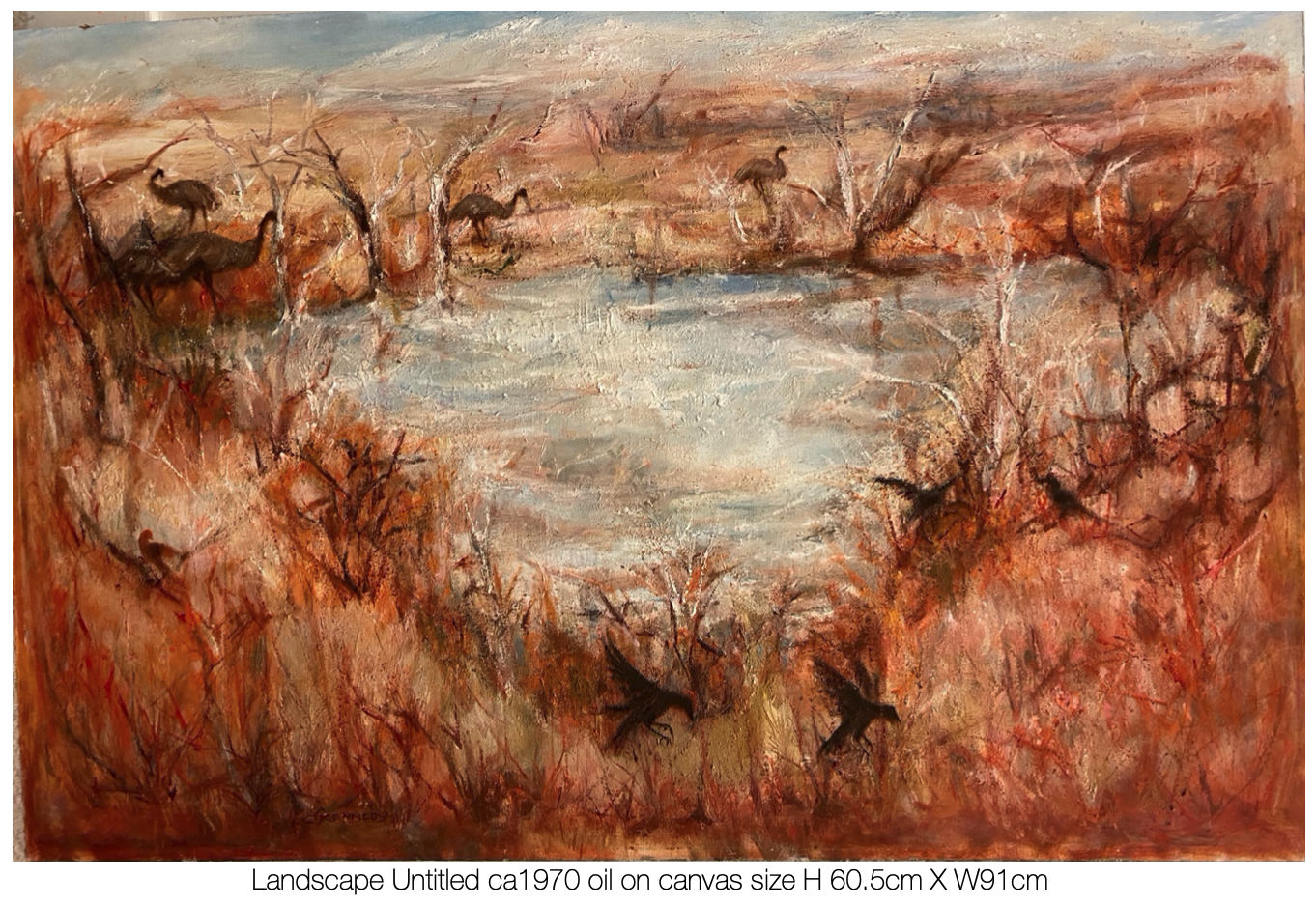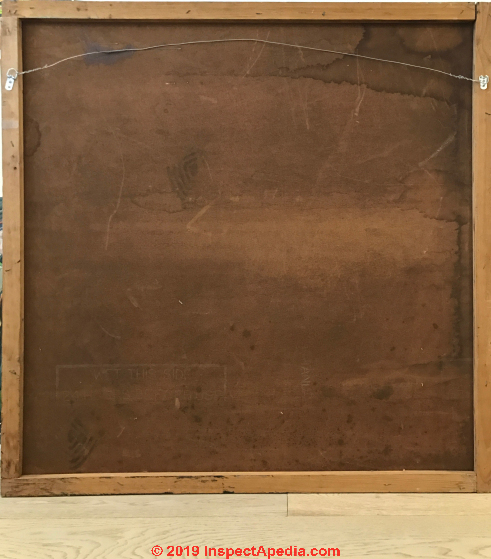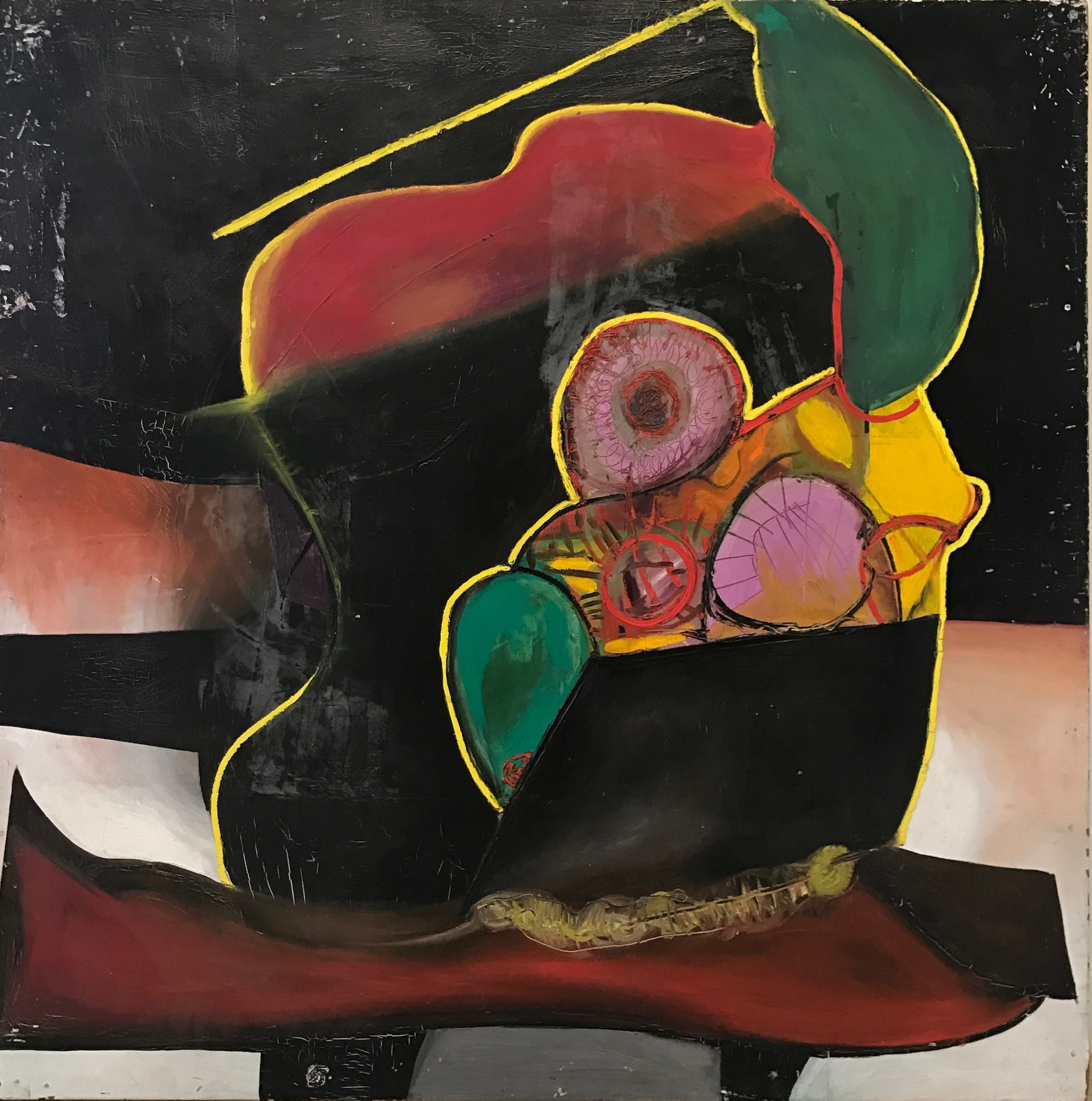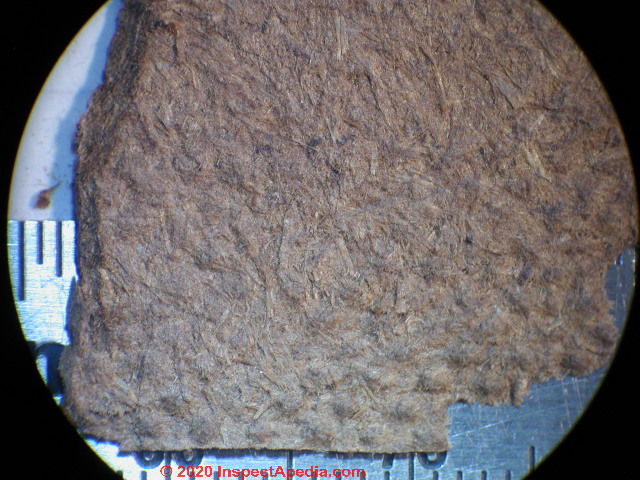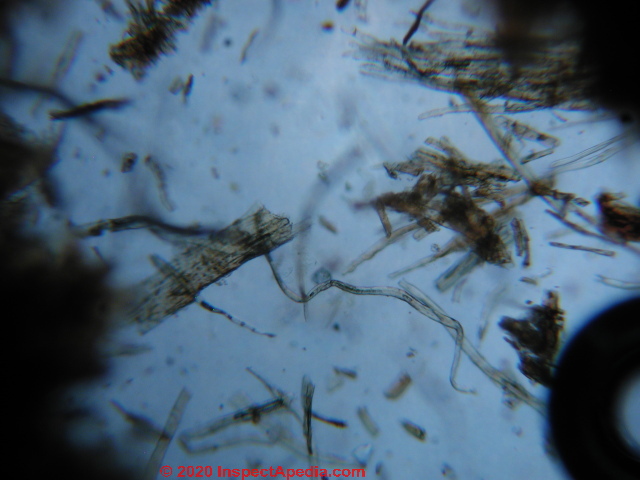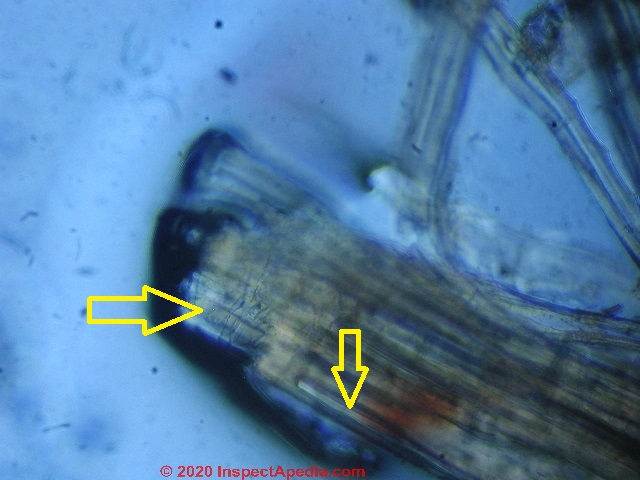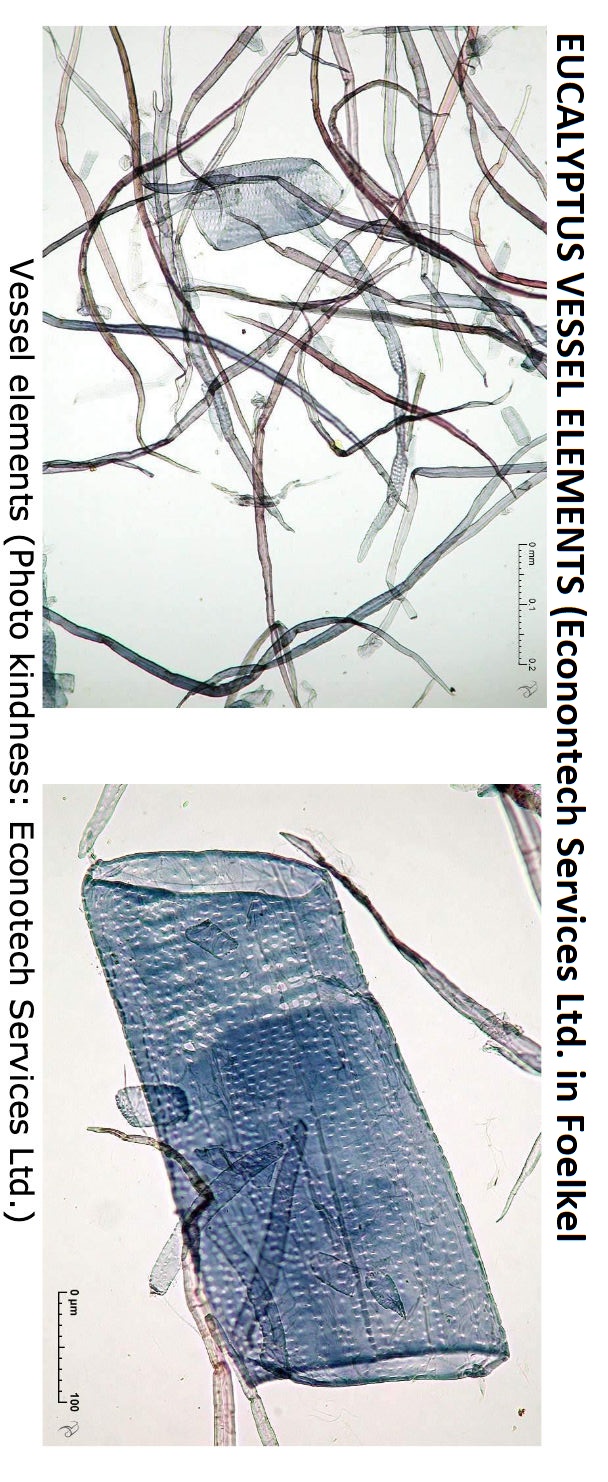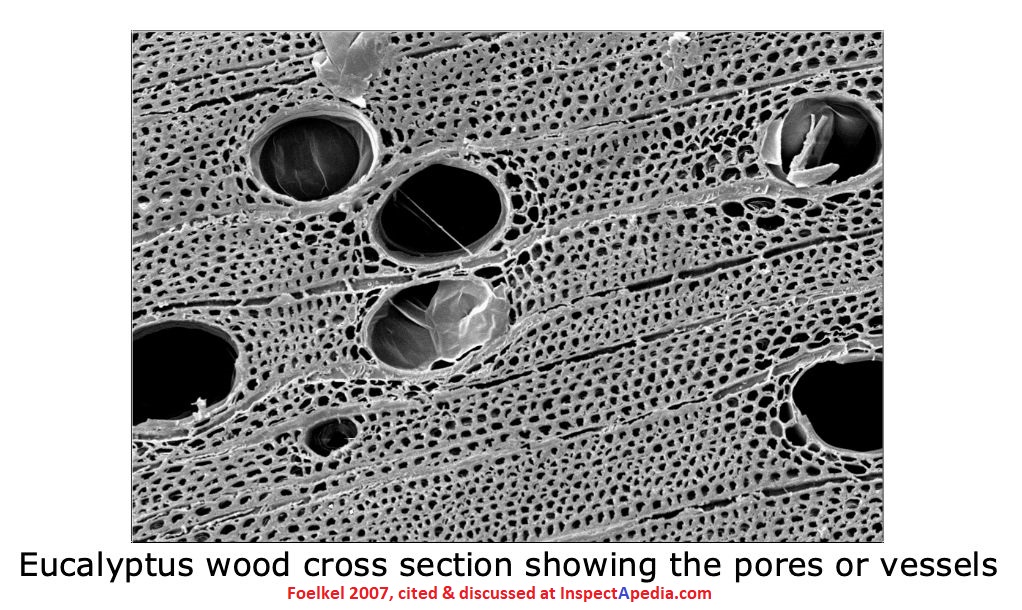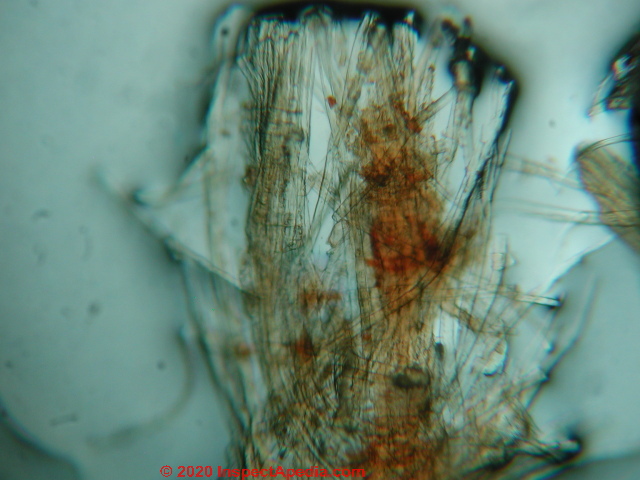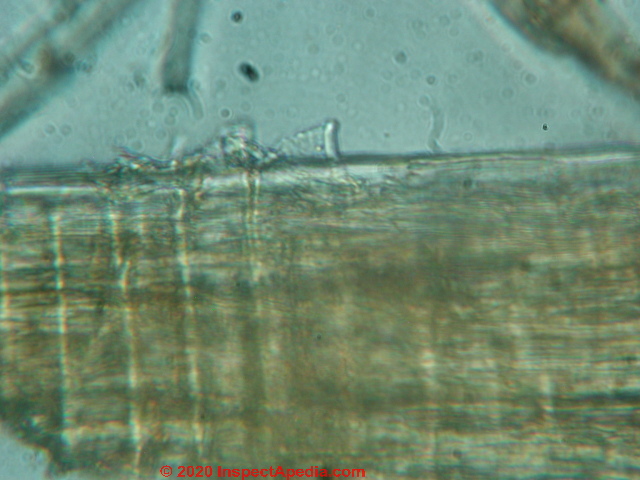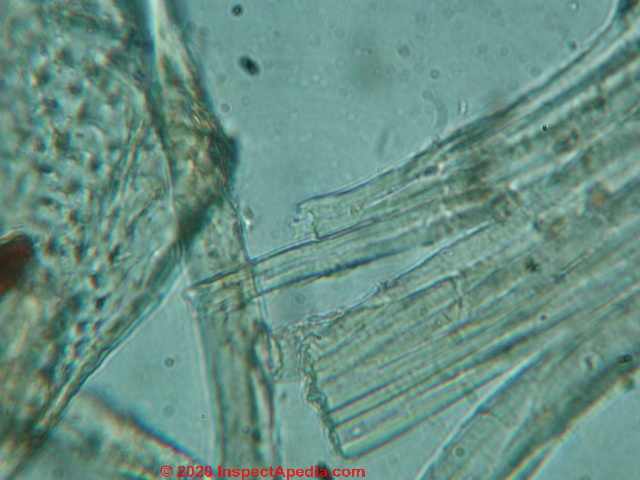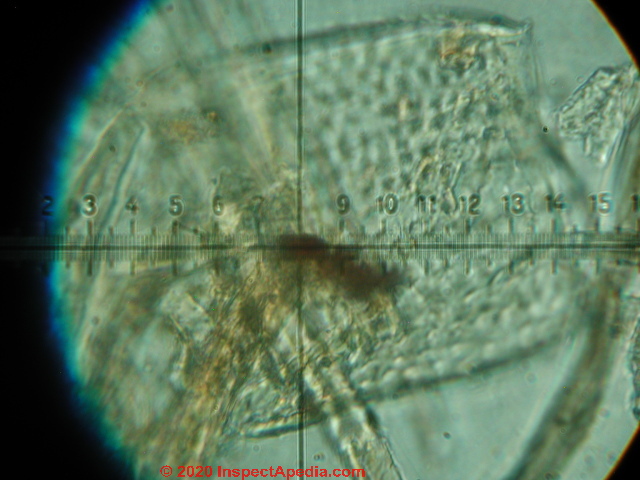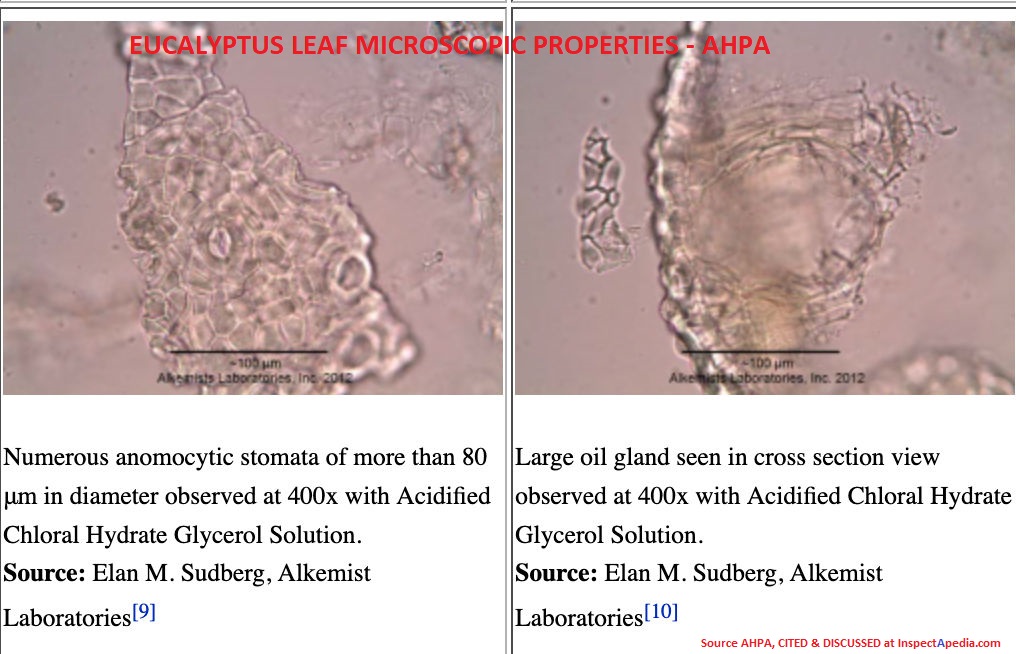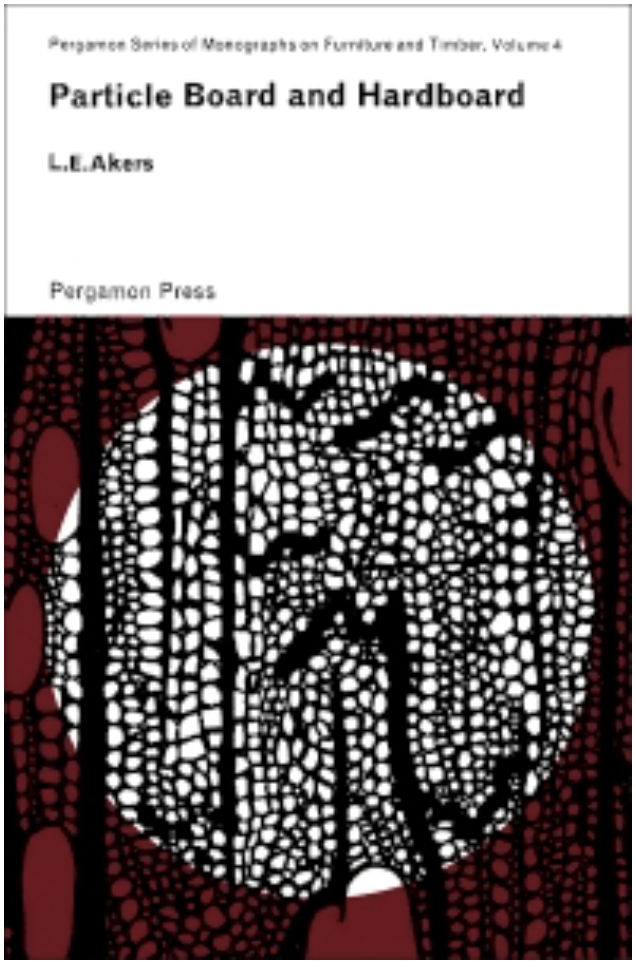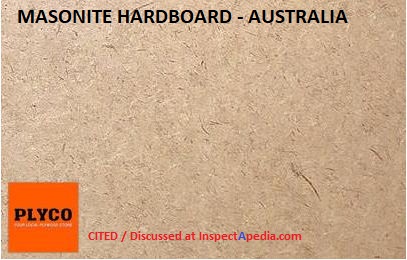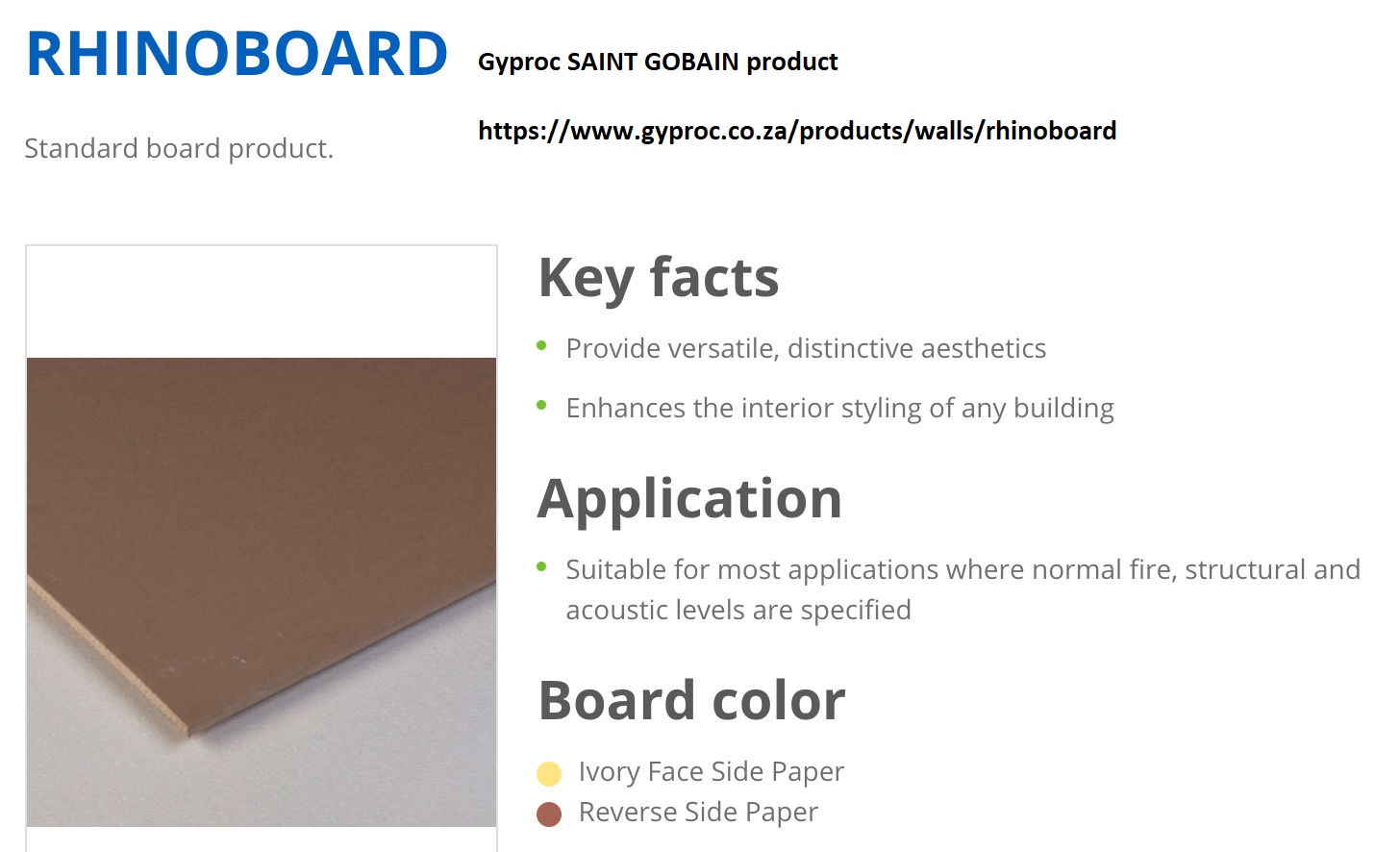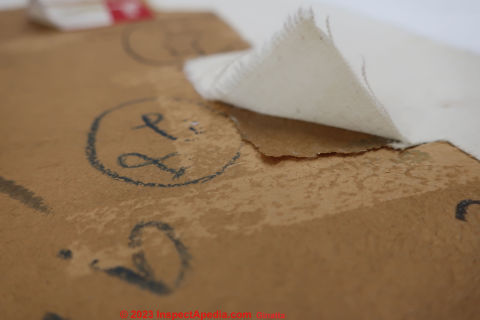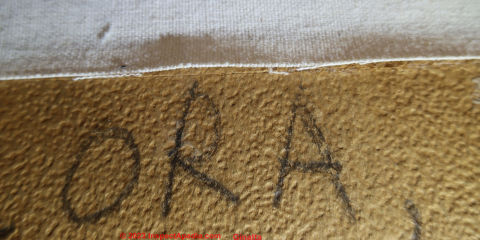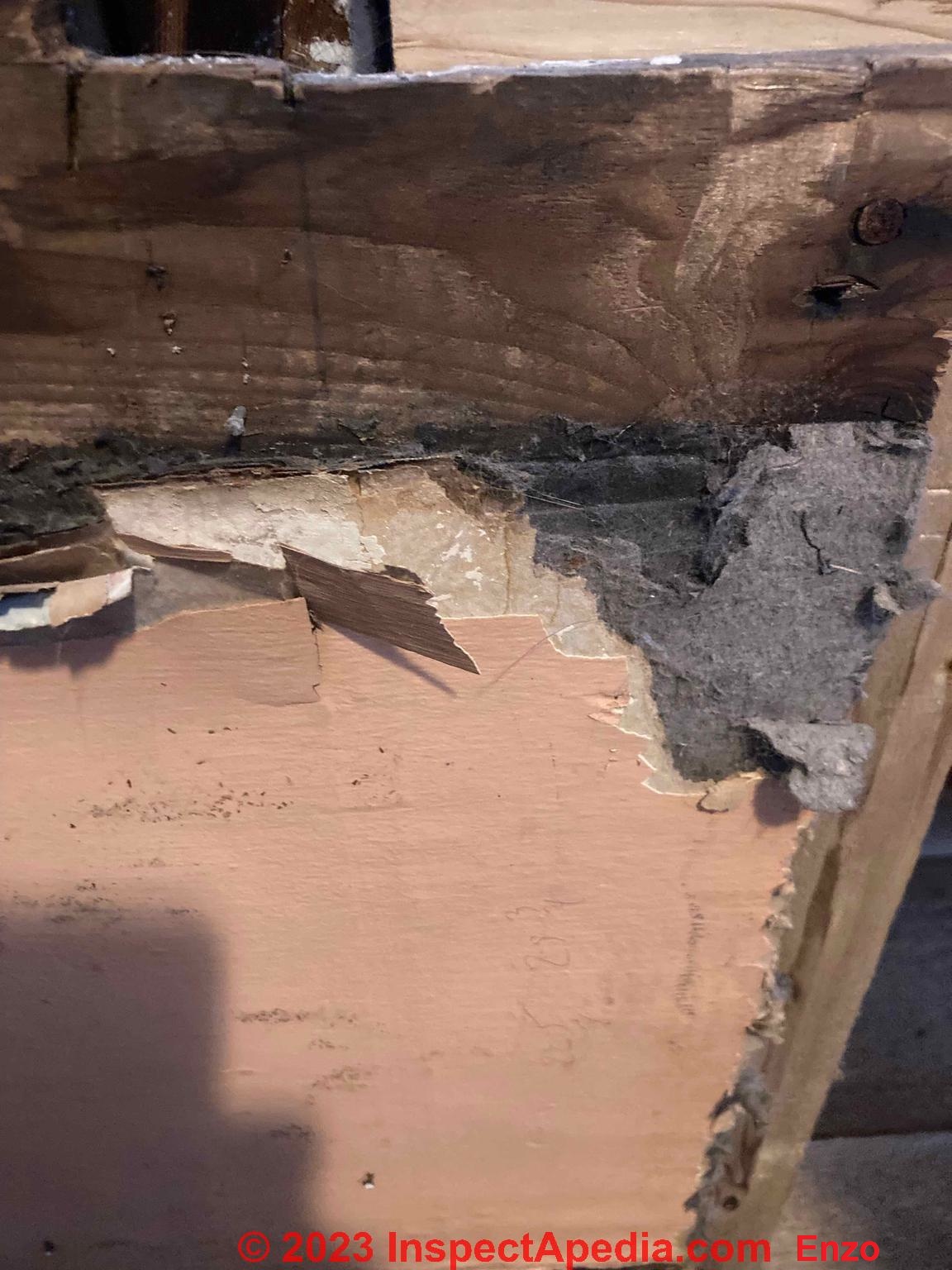 Fiberboard / Hardboard Base for Artworks
Fiberboard / Hardboard Base for Artworks
Masonite™ Hardboard, HDF, MDF or LDF Based Paintings
- POST a QUESTION or COMMENT about the history, use, & identification of various board products used as a base for painting & other works of art.
Since early in the history of production of various board products made of wood, pulp, or similar materials, these boards have been used by many artists as a a base for paintings and occasionally in other works of art. Here we discuss the use, identification, and conservation of these artworks.
Photo at page top: Antique S1S wet-process Masonite™ hardboard showing the back side of an early hardboard interior-use product labeled "Genuine 4 Masonite De Luxe QuartrBoard © InspectApedia.com.
This article series describes various kinds of building materials and give the history and dates of their first (and in some cases last) use in residential and light commercial construction.
InspectAPedia tolerates no conflicts of interest. We have no relationship with advertisers, products, or services discussed at this website.
- Daniel Friedman, Publisher/Editor/Author - See WHO ARE WE?
Artworks & Paintings On Masonite™ Hardboard HDF & MDF & Other "Board" Products
Wood, cane, or other plant-based high density fiberboard (HDF) has been used as a backer for works of art for roughly 100 years.
[Click to enlarge any image].
Above: Masonite™ fragments (wood fibres) isolated from a surface sample of an oil painting that was executed on a hardboard substrate.
At PAINT FAILURE, DIAGNOSIS, CURE, PREVENTION we explain why tempered hardboard may suffer brown bleed-through staining when painted if it is not properly sealed first.
Above: S1S Dry Process Masonite™ used as substrate for a painting whose owner was concerned that the product might contain asbestos (highly unlikely).
The hardboard shown above and the painting on its other side are discussed in detail
at HARDBOARD Masonite™-like INGREDIENTS
HDF and MDF in Artworks in Germany & E.U.
The hardboard identification photographs below are examples of HDF and possibly some MDF (medium-density fiberboard) used in artworks, provided by Ulrik Runeberg (Germany), Marcus Joshmar (Australia) and others.
The selection of different hardboard products include Masonite, but also a lightweight Sundeala board and other MDF products. - Ulrik Runeberg
The VEB Ribnitz-Damgarten panel [above] is an east german product (GDR, ca 1970´s - 1980´s).
The enterprise doesn´t exist any more, but according to information in the internet, this brand was highly successful, and the enterprise quite modern back in those times (constructed with Swedish machinery).
Above: The painting detail is from the 1950´s or early 1960´s (unidentified). - U.R. .
Below: examples of HDF MDF used in European art works.
I found the hardboard-artwork samples below at work in our Archive, and I assume that they were collected by Heinz Althöfer, the founder of the Restaurierungszentrum, in the 1970s. - U.R.
The Upper two samples are Sundeala Board, which is the lightweight fiberboard Made with paper divers.
It was Süd by Francis Bacon for a triptych (3 panel painting) which is at Tate in London and quite popular in the late 1960's among leading restorers, worldwide.
The first deteriorates, though is unstable (quicklebendig); It loses flexibility and pulverizes especially when exposed to sunlight.
The second pair Seems to be high density hardboard, whereas the Last pair is Mit freundlichen Grüßen
Special Thanks & References for Artworks on Plant-based or Wood-Based Boards
- Boustead, William. "The conservation of works of art in tropical and sub-tropical zones." Studies in Conservation 6, no. sup1 (1961): 73-78.
- Chiliadaki, Argyro & Andre Page, A NEW ZEALAND COMMUNIST PARTY MURAL, POSTER PAINTS ON LARGE FORMAT FIBERBOARD [PDF] Themen, Restauro
- Ciferri, Orio. MICROBIAL DEGRADATION of PAINTINGS [PDF] Applied and environmental microbiology 65, no. 3 (1999): 879-885. [PDF]
- Colpitt, Frances. "The Shape of Painting in the 1960s." Art journal 50, no. 1 (1991): 52-56.
- Galleries, Skelton. "Cover:" Haliburton Highlands" Kenneth Cameron 1919-1996 Oil on masonite 102× 122 cm Cameron's paintings are available from." Can J Rural Med 2, no. 4 (1997)
- Joshmar, Marcus, Melbourne Australia, private correspondence (2021/01/17 & other) r <marcusjoshmar@gmail.com>.
- KENNEDY, CLEMENT, ARTIST BIO [PDF] courtesy of M.J.
- Runeberg, Ulrik, STAINING AND MICROBIOLOGICAL INFESTATION OF ACRYLIC PAINTINGS ON HARDBOARD [PDF] Ulrik Runeberg, Conservator (Dipl. Rest./M.A.), Restaurierungszentrum der Landeshauptstadt Düsseldorf, Germany, Email: Rune-Ulrik@gmx.de
Previously Museo de Arte Contemporáneo de Puerto Rico, San Juan Presented, April 2007 conference in Richmond Virginia, sponsored by the AIC (American Institute for Conservation),
this paper discusses the staining and microbial infestation of acrylic paintings on hardboard. - private correspondence, ER <->DF 2020/01/05 - 2006/09/12.
in AIC Paintings Specialty Group Postprints, Vol. 20, 2008, American Institute for Conservation (AIC) of Historic and Artistic Works, & Foundation for Advancement in Conservation (FAIC), 727 15th St. N.W. Suite 500, Washington D.C. 20005 USA, Tel: 202.452.9545 Email: info@culturalheritage.org original source: https://www.culturalheritage.org/docs/default-source/periodicals/paintings-specialty-group-postprints-vol-20-2007.pdf
ABSTRACT
Hardboard served as a common and popular support for many modern and contemporary paintings. S
ome artists considered hardboard to be a stable, light and economic alternative to solid wood panels and other rigid supports, whereas others rejected the processed and compressed wood fibre boards as an inferior industrial construction material of low aesthetical value.
Also see PAINT FALURE, DIAGNOSIS, CURE, PREVENTION - Runeberg, Ulrik, Hartfaserplatten als Bildträger, Konstruktions- und Restaurierungsmaterial. Historische, materialimmanente und ästhetische Aspekte eines Holzwerkstoffs in der Kunst
- Hardboard as image carrier, construction and restoration material. Historical, material immanent and aesthetic aspects of a wood material in art [PDF] Fahne, - Smith, Kari, Kristin Horton, R. John Watling, and Natalie Scoullar. "Detecting art forgeries using LA-ICP-MS incorporating the in situ application of laser-based collection technology." Talanta 67, no. 2 (2005): 402-413.
- SUNDEALA BOARD COMPOSITION & HISTORY [Web Article]
HDF & MDF in Artworks in Australia
The HDF/MDF samples and artwork examples below are provided courtesy of Marcus Joshmar.
Above and just below - Verso: Back of painting - Landscape with Emus & Crows,Untitled, by Clement Kennedy, ca 1970? - M.J.
Below: the painting - Landscape with Emus & Crows, Untitled, ca 1970, by Clement Kennedy. [1894-1976] - op. cit.
Also see HISTORY of MASONITE HARDBOARD in AUSTRALIA - including works of art
Question: can you tell me the age of this Masonite™ Used as Artwork Substrate?
Above: Hardboard reverse and painting possibly ascribed to Francis Bacon, under study by the correspondent, Marc Joshmar <marcusjoshmar@gmail.com>.
[Click to enlarge any image]
I am an artist residing in Australia and sometimes I do some art restoration work.
I have read your very interesting article on your website, "Fibreboard Identification" [now found at ]
HARDBOARD MASONITE™ & OTHER BRANDS
that you provided previously in FRAMING MATERIALS, Age, Types
I was wondering if you could please assist me in identifying the age and type or fibreboard that I am working with for this current restoration project [Please refer attached photos]
Photos: S1S Dry Process Masonite™ or a similar product used as artwork substrate for a painting under restoration in Australia.
[Click to enlarge any image]
As you can see the substrate appears fairly old, could it be 30's, 40's, 50's etc?
Photos: Here I show the back of the painting showing the hardboard or "Masonite™" type substrate.
[Click to enlarge any image]
I was told this work is from the U.S., so I guess the fibreboard is from an American Company?
The piece is
- 48" X 48" x 1/8" thick
- it says "Wet this side 24 hours before use"
- and "Standard" and it also has a stamping on it.
- It has screen textured on one side and smooth on the other side.
I would appreciate any information you may glean from this, and I thank you very much for your time and effort. - Anonymous by private email 2019/12/23
Reply: hardboard, probably Masonite™ imported or made in Canada or Sweden or the U.S., later in Australia & elsewhere
Anon:
By including this discussion online we invite other readers to offer comment or suggestion by using the Comments Box at page bottom or by contacting us by email.
1/8 inch thickness and wet before using sounds like a hardboard used or intended to be used as a plaster base. That would explain the "Wet 24 hours before use" instruction marked on the product.
The hardboard looks like S1S "Dry Process" Masonite or one of its competitors; details are given on this page and also in our separate article
HARDBOARD Masonite™-like INGREDIENTS
Fiberboard used as a plaster base is described in still more detail
at FIBERBOARD PLASTER BASE SYSTEMS though most of those were a thicker, softer board than what is in your photo.
That hardboard (basically a wood product) is still in production and sold for various purposes.
Reader follow-up:
Thank you very much for your reply, I checked out the links, excellent.
You mentioned the hardboard is probably masonite, [I agree] and you said that it is still in production today.
Is there any way of knowing how old this piece is, like 40 years old, 50 years old etc..?
There is a black stamp mark on the board, I wonder if anyone can identify the mark, that would give a 'round about date' please find attached photo.
As a art restorer this would greatly assist me in identifying the age of the painting also.
Moderator reply:
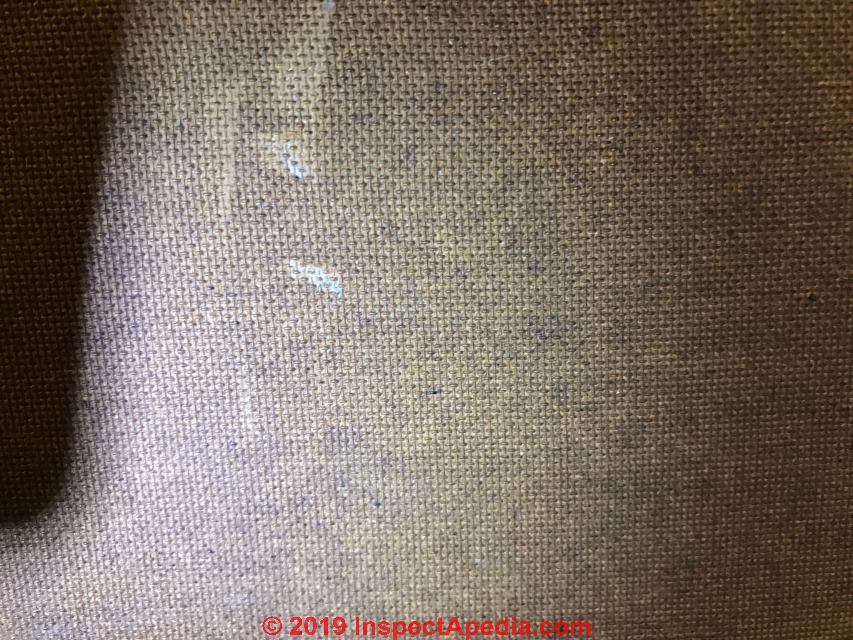 Versions of hardboard or fiberboard made from wood products has been made so long and used in artworks as early as 1861 ( Katlan 1994) so I'm not confident that one can identify its age by inspection alone.
Versions of hardboard or fiberboard made from wood products has been made so long and used in artworks as early as 1861 ( Katlan 1994) so I'm not confident that one can identify its age by inspection alone.
You didn't give the origin of the painting on masonite about which you inquire, but artists in North America were using hardboard as a painting support as early as the late 1920s.
However the screen-imprint on the back side of your hardboard tells us that it's a modern wet-process HDF, no older than the 1930s. In the U.S. Mason's key fiberboard patents (the progenitor of the product name Masonite™) date from 1926 to 1933.
When working on a book on works by Frida Kahlo we, working with the owners, had various paint chemistry tests done that, country dependent, can bracket the age of a painting. On paper works we looked also at ink pigment migration down through layers of the material as an age confirmation.
You probably know that some chemicals in some pigments had definite eras of use, such as lead white and real cadmium in cadmium yellow. The tests are not cheap and have to be done by an expert lab.
In my own research on paint analysis, some of which involves simple microchemistry that I've done in the lab, I found that some of the expensive paint tests using spectrometry gave completely inept amateur result, almost certainly at the fault of the specific lab technician, so if you go that route be sure to have a frank discussion with the lab before hiring someone.
My friend Ulrik Runeberg is still at this email rune-ulrik@gmx.de - you might try giving him an email as Ulrik is IMO an expert restoration person who also has worked on artworks on hardboard and masonite. From the photos Ulrik had this view:
I only can guess and in my opinion confirm that the hardboard dates back perhaps to the 1940s, since the structure is a kind of irregular. Later hardboards from the 1960s usually appear more sophisticated (although it seems to me that in countries such as Brasil, hardboard was processed well until into the 1960s on wire mesh, for the drying process). - U.R. private email to DF 2019/12/31
Most likely your "Masonite" or hardboard (if it was made by someone else) dates from the 1940s to 1960s and was either imported or produced in Australia under license as William Mason for use of the Masonite™ brand and its production methods (compressed wood chips, heat, bonding agent first produced in the U.S. probably in Mississippi) in Australia, Canada, Italy, and Sweden to produce its hardboard that some writers call "hardwood".
That the "WET 24 HOURS BEFORE USE" indicates that your specific Masonite™ product was sold for use (not exclusively of course) as a plaster base.
The detailed history of Masonite is available from several sources including beginning here at HARDBOARD MASONITE™ & OTHER BRANDS (you are on this page)
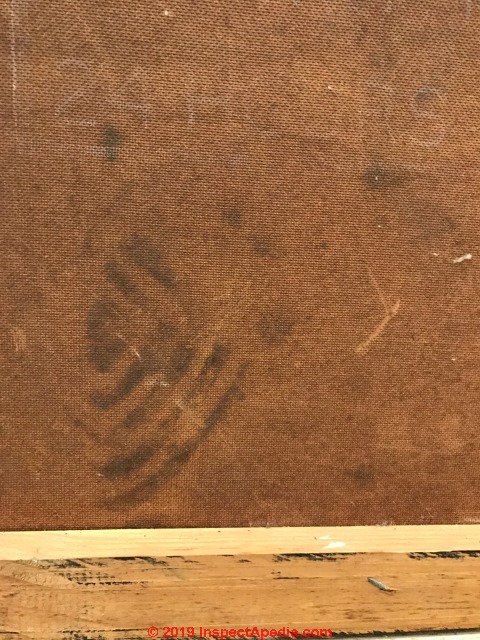 The Masonite Corporation (Australia) was founded in Australia in 1938, renamed in 1955 as Masonite Holdings. If your Masonite board is stamped "Canada" it doubtless came from Canada.
The Masonite Corporation (Australia) was founded in Australia in 1938, renamed in 1955 as Masonite Holdings. If your Masonite board is stamped "Canada" it doubtless came from Canada.
Australian Masonite hardboard produced by that company was manufactured from eucalypts and was considered stronger than similar "hardboard" products made from softwoods.
So if we really needed to identify the exact hardboard you have, a microscopic examination of its fibres to distinguish between eucalyptus hardboard and softwood (pine) based hardboard is technically possible.
You may be able to do some research to find the date when Masonite was first licensed in Australia - on the PRESUMPTION that your hardboard was produced in-country rather than imported.
Photo above/left: the black "Stamp" is in my [DF] OPINION not an identification marking but is more-likely a boot or shoe print.
[Click to enlarge any image]
If imported then your Masonite-backed painting may pre-date in-Australia production of that product.
MASONITE & HARDBOARD CEILING & WALL COVERINGS also discusses this.
We don't know for certain (yet) but probably this is a true Masonite™ board.
The paint failure (extractive bleeding of masonite through paintings) work I did with Ulrik is discussed briefly at
PAINT FALURE, DIAGNOSIS, CURE, PREVENTION
Microscopy lab photographs of samples of the Australian Hardboard
We hoped to be able to identify the wood fibres comprising this hardboard, at least to determine if they are distinctly from pine or from eucalyptus; the latter might argue for an Australian origin of this product.
Photos shown above and below give that work as in-progress; further research is needed.
Our photographs include a macroscopic image under the stereo microscope (above) followed by images in the light microscope using transmitted and polarized light (below) as well as some reference images from research on the identification of Eucalyptus fibres using light microscopy.
Among the research citations below we have added resources that help describe the identification of eucalyptus wood both macroscopically and microscopically.
To date the microscopic identification of eucalyptus that we've found has been of the leaf, and some research characterizing Eucalyptus wood fibres.
These are wood fibres but more detail is needed to distinguish between pine or other fir fibres and eucalyptus wood.
But in my polarized light photograph above and in an excerpt from my photos of this hardboard under the microscope
I point to or encircle in yellow vessel elements that might be consistent with Eucalyptus
and that would distinguish it from fir, pine, or softwood, as described in contemporary research (Foelkel 2007) from which the photo below is excerpted.
Excerpting from Foelkel:
The presence of vessels is obligatory in the hardwoods. In case a wood has no vessels, it is not considered to be a dicotyledonous angiosperm. If it has them, it is a hardwood. It is the case of the well-known tree called casuarina.
Because of its outside appearance, it is very similar to a conifer pine tree, but as a matter of fact it is a hardwood, it has vessels, which are even quite characteristic.
The conifers form wood that has only tracheids (fibers) and parenchyma cells, whereas the hardwoods have fibers, parenchyma and vessels. (Foelkel 2007 p. 7) The illustration of vessels in Eucalyptus wood below are from Foelkel p. 8.
Additional Micro-photographs of this Australian Masonite hardboard
After soaking a sample of this Aussie hardboard in propanol and water for 25 days we were able to obtain additional, better-hydrated examples of the fibres that constitute this product, as illustrated here.
...
...
...
Research on Use of Wood Fiber Panels in Art: Masonite™, Celotex™, Hardboard HDF, MDF, Softboard
- Abruzzi, Rafael C., Berenice A. Dedavid; Marçal J. R. Pires; Suzana F. Ferrarini, Relationship between density and anatomical structure of different species of Eucalyptus and identification of preservatives, [PDF] Materials Research
Print version ISSN 1516-1439 (September 10 2013) https://doi.org/10.1590/S1516-14392013005000148
Abstract:
The species and density of Eucalyptus wood poles installed in the electrical network are useful parameters which must be considered when it is necessary to establish the service life of these structures. In this work, eucalyptus poles samples were collected and analyzed by scanning electron microscopy and energy dispersive spectroscopy (SEM/EDS).
SEM image analysis showed that the lumen diameter average of fiber substantially is variable between the three species studied, in line with the wood density obtained in laboratory, for poles with several years in service in the electricity network, as well as for not used poles.
In addition, EDS microanalysis was utilized for identify the presence of chemical preservatives employed in the conservation these poles. The analysis method proposed proved effective for characterization for this timber. - Adamopoulous, Stergios, IDENTIFICATION OF FIBRE COMPONENTS IN PACKAGING GRADE PAPERS [PDF] AIDIMA, Wood, Furniture and Packaging Technology Institute, Technology Park of Valencia, 13 Benjamin Franklin, P.O. Box 50, 46980 Valencia, Spain
Summary:
Environmental and economic issues have led to a significant increase of recycled paper as the main fibrous component of corrugated board the last years. Qualitative data on the different fibre types are needed for the evaluation of packaging fibre supply sources, which are becoming numerous and heterogeneous.
Fifteen different packaging grade papers (7 linerboards and 8 corrugating medium) were selected to represent all the variety of papers available on the Spanish market. The origin of virgin and recycled fibres was identified by their morphological characteristics employing light microscopy and standard fibre analysis techniques.
The waste-based papers (Waste based-liners and Fluting), Kraft-liners and Test-liner were highly variable containing 9–18 different wood and non-wood components.
Semi-chemical, with 5–13 components, was the less variable grade. Hardwoods were identified as the most important fibre component from a quantitative standpoint. All papers contained in their hardwood mix Betula, Eucalyptus and Populus in significant amounts.
Fagussylvatica and Tilia were also frequently observed and in some papers were amongst major hardwood components.
Prominent softwood components were found to be Pinus sylvestris, P. pinaster, P. radiata, Picea, Larix and in some papers Pinus nigra. The lower presence of a variety of softwood, hardwood and nonwood (mainly grasses) species and genera was due to the paper recycling process.
- AHPA, EUCALYPTUS [LEAF] , MACRO & MICROSCOPIC PROPERTIES [PDF], American Herbal Products Association, retrieved 2020/10/24 original source: http://www.botanicalauthentication.org/index.php/Eucalyptus_globulus_(leaf)
Excerpts:
Under the microscope sections of Eucalyptus show the upper and lower surfaces with nearly similar cells, the outer walls being strongly cuticularized;
stomata occur on both surfaces, a region of palisade cells made up of from 3 to 4 rows of cells occurring beneath each surface; among the palisade cells occur large oil-secretion reservoirs, with a yellowish or orange colored oily content; calcium oxalate crystals in cells of the loose mesophyll in the form of rosette aggregates or monoclinic prisms varying from 0.015 to 0.025 mm. in diameter.
At the periphery of the fibro-vascular bundles of the midrib and petiole occurs a more or less interrupted circle of small groups of slightly lignified bast-fibers.
- Akers, LE Particle Board and Hardboard Pergamon Press, London and New York, 1966, eBook ISBN: 9781483155449
Description
Pergamon Series of Monographs on Furniture and Timber, Volume 4: Particle Board and Hardboard focuses on particle boards, which are described as a sheet material manufactured from small pieces of wood or other ligno-cellulosic materials agglomerated by use of an organic binder together with agents such as heat, pressure, moisture, and catalyst.
This book is divided into two parts. Part I concentrates on the types; methods of manufacture; physical and strength properties; tests, test methods, and quality evaluation; handling and machining; utilization in furniture and building of particle boards. In Part II, a brief discussion on the types, manufacture, properties, and applications of hard board is provided.
The last part of this text is devoted to a glossary of terms relating to particle board, hardboard, and similar products. This volume is valuable to builders, architects, joiners, furniture designers, interior designers, and manufacturers of any products requiring flat, plane surfaced material for painting, veneering, or the application of laminated plastics.
Excerpt: A product resembling masonite (hardboard) was first made in England in 1898 by hot-pressing waste paper ... - Ampersand Art, The Story of HARDBOARD [PDF] Ampersand Art Supply, 1235 S Loop 4, Suite 400 Buda, TX 78610 USA Tel: (800) 822-1939 / (512) 322-0278 outside the US Website: https://ampersandart.com/ retrieved 2019/12/31 original source: https://ampersandart.com/the-story-of-hardbord.php
- ARTWORK MOLD CONTAMINATION - includes analysis of mold on artworks on Masonite™
- Carillo-Varela, Isabel, Paulina Valenzuela, William Gacitúa, and Regis Teixeira Mendonça AN EVALUATION OF FIBERBIOMETRY AND NANOMECHANICAL PROPERTIES OF DIFFERENT EUCALYPTUS SPECIES [PDF] BioResources14(3), 6433-6446.
Abstract:
Wood fibers from seven Eucalyptus species were collected to investigate the relationships among species, fiberbiometry,and nanomechanical properties. The results indicated significant differences in wood density, coarseness, fiberlength, fiber width, and cell wall thickness among the different Eucalyptus species. The nanomechanical properties of the S2 cell wall layer also showed significant differences among the Eucalyptusspecies.
The elasticity modulus ranged from 16 to 19 GPa, the hardness spanned 0.24to 0.31 GPa, andthe ductility ratio was between 54 and 68. Moreover, significant correlations were observed for hardness versus cell wall thickness (r=0.87), and elasticity modulus versus crystallinity index (r=0.80) and crystallite size (r=0.68).
Among the evaluated species, E. dunnii showed the highest elasticity modulus, highest hardness average, and the highest crystallinity index. The range of nanomechanical values indicated that Eucalyptu swood fibers are suitable for the development of new composite materials or engineering products by selecting the most adequate species for each use according to its properties. - Carll, Charles. Review of thickness swell in hardboard siding: Effect of processing variables. Vol. 96. US Department of Agriculture, Forest Service, Forest Products Laboratory, 1997.
- Caruso, Hwa Young, and John Caruso Jr. "Art Review: Jacob Lawrence’s African American Migration Series-1915 to the 1950s." International Journal of Multicultural Education 17, no. 3 (2015): 119-127.
Excerpt:
And the Migrants Keep Coming, 1941, Jacob Lawrence, casein tempera on hardboard, 12 x 18 in. 14. - Elger, Dietmar. Expressionism: a revolution in german art. Taschen, 2002
Includes citation:
1912 Hussisches Ballett Oil on hardboard, 103 x 81 - Fairbrass, Sheila. "Sticky problems for conservators of works of art on paper." International journal of adhesion and adhesives 15, no. 2 (1995): 115-120.
Excerpt:
it is quite another matter to use a solvent treatment on a poster measuring three feet by five which has been laminated to a piece of hardboard … - FIBERBOARD SHEATHING IDENTIFICATION - a key to identifying brands and types of fibreboard
- Foelkel, Celso, VESSEL ELELEMENTS AND EUCALYPTUS PULPS [PDF] (2007) Eualyptus online book & newsletter, retrieved 2020/10/24 original source: http://www.eucalyptus.com.br/capitulos/ENG04_vessels.pdf
- Friedman, Daniel, BALSAM WOOL vs CELLULOSE INSULATION [Web article] InspectApedia.com
- Friedman, Yona. "The Renaissance City by Giulio Argan, and: The Modern City: Planning in the 19th Century by François Choay, and: Le Corbusier: The Machine and the Grand Design by Norma Evanson, and: Toney Gamier: La Cité Industrielle by Dora Wiebenson." Leonardo 3, no. 4 (1970): 479-479.
Note:
Cites lithographs printed from hardboard - Gomes, Fernando José Borges, Jorge Luiz Colodette, Auphélia Burnet, Larisse Aparecida Ribas Batalha, Fernando Almeida Santos, and Iara Fontes Demuner. THOROUGH CHARACTERIZATION OF BRAZILIAN NEW GENERATION OF EUCALYPT CLONES AND GRASS FOR PULP PRODUCTION International Journal of Forestry Research 2015 (2015).
- Goodwin, Mary. "Conservation of the Tattooed Lady, a collage by Peter Blake (b. 1932–)." The conservator 5, no. 1 (1981): 9-11.
Excerpt:
This was drummed onto the painted hardboard backing to form an isolating layer between the re-supported collage and the hardboard - Gregory, Richard L. "The most expensive painting in the world." (2007): 1-2.
Abstract:
It has been reported (The Times 3rd November 2006) that Jackson Pollock's dribble painting `1948 no 5' has been sold for $140 million (»73 million), making it the most expensive picture in the world.
As well known, its several colours of paint are dribbled from the brush, not so much moved as held, while the paint forms intricate patterns on a large sheet of hardboard. This often takes place out of doors in the garden, gentle gusts of wind making significant contributions.
A critic might say the artist's main job is to watch the paint drying. But this is not at all what critics do say, and the monetary value suggests that this is a very exceptional work of art by an extremely gifted painter, famous for his dribbled pictures.
They are intricate, and one might well say fascinating, patterns of course with no claim to represent objects. They may, however, capture statistical features of familiar objects or scenes
Excerpt:
As well known, its several colours of paint are dribbled from the brush, not so much moved as held, while the paint forms intricate patterns on a large sheet of hardboard - Gottsegen, Mark David. A manual of painting materials and techniques. Harper & Row, New York, 1987. ISBN 0-06-042421-4
- Gottsegen, Mark, PAINTING on PANEL: WORKING WITH MASONITE [PDF], Ampersand Art, retrieved 2019/12/31, original source: https://ampersandart.com/blog/2013/04/painting-on-panel-working-with-masonite/
Note:
For more detailed and technical (believe it or not) information on hardboard and Hardbord™, please refer to our website: ampersandart.com/tips/archivalinfo - Gutierrez, Lydia. "The painting materials and techniques of Ralph Hotere's black nitrocellulose lacquer works 1967 to 1977." Journal of the Institute of Conservation 32, no. 2 (2009): 181-204.
- Hackney, Stephen. THE EVOLUTION OF A CONSERVATION FRAMING POLICY AT TATE [PDF] Museum Microclimates, T. Padfield & K. Borchersen (eds.) National Museum of Denmark 2007
ISBN 978-87-7602-080-4 retrieved 2020/01/26 original source: https://www.conservationphysics.org/mm/hackney/hackney.pdf
Excerpts:
Backboards became a mainstay of conservation policy. Since they are not seen, there are few constraints on their application and backboards have been applied to all paintings in the collection [11]. If rigid backboards are used, they can protect from impacts from the reverse during handling.
Even unframed or minimally framed paintings can have a backboard applied to their stretcher or to a special transit/handling frame to provide similar protection. Backboards can also be dust seals and impermeable moisture barriers.
Earlier cloth backings were replaced with hardboard backboards with ventilation vents. Measurements were carried out on the permeability of backboards [12]. As a result oil-tempered hardboard backboards, which were well sealed with screws and tape, were adopted in order to reduce significantly moisture transfer.
In conjunction with glazing, the effectiveness of backboards proved to be much better than expected. Simple seals and moisture barriers created extremely stable relative humidity (RH) conditions within frames, which could be measured by newly available RH/T data loggers. - Hackney, Stephen. "Framing for conservation at the Tate Gallery." The Conservator 14, no. 1 (1990): 44-52.
Excerpt:
… with a well sealed frama By using vapour barriers to exclude pollution and sacrificial material that reacts with the pollutant (eg hardboard) ...
- Hoeck, Hans Jürgen, ZUR DATIERUNG FRÜHER, HARTFASERPLATTEN [PDF] [For dating earlier hardboard] in MUSEUM AKTUELL 231 2016 pp. 22-32
Thanks to Ulrik Runeberg for this reference. - Hutchinson, Mervyn. "PART III: CASE STUDY OF PICTURES BY COLIN McCAHON." AICCM Bulletin 11, no. 4 (1985): 63-70.
Excerpt:
The hardboard also has a tendency to warp as it is not usually sealed on both sides …
- Katlan, Alexander W. EARLY WOOD-FIBER PANELS: MASONITE, HARDBOARD, AND LOWER-DENSITY BOARDS [PDF] Journal of the American Institute for Conservation 33, no. 3 (1994): 301-306. Published online: 18 Jul 2013..
Abstract:
The author discusses the early use in the 19th and 20th centuries of lignocellulose fiberboards by artists.
Hardboards and “Masonite process” boards are defined and discussed, and patent dates are clarified, including the possibility that fiberboards were available to artists as early as 1861, judging by two British patents of that date, and the fact that wood-fiber boards were commercially manufactured in England by 1893.
The advantages and disadvantages of Masonite as an artist's painting support are discussed, as is a new Masonite-type hardboard that recently was introduced. - Kostadinovska Maja, Zorica Jakovleska Spirvska, A PROCEDURE FOR IDENTIFYING CELLULOSE FIBERS IN PAPER ARTIFACTS - Differentiating between flax, hemp and cotton [PDF] (2016) The 4th International Virtual Conference on Advanced Scientific ResultsJune, 6. - 10. 2016, www.scieconf.com
- Katlan, Alexander W. Early wood-fiber panels: masonite, hardboard, and lower-density boards [PDF] Journal of the American Institute for Conservation 33, no. 3 (1994): 301-306. [Copy on File at InspectApedia.com as Early-Wood-Fiber-Panels-Masonite-Hardboard-and-Lower-Density-Boards.pdf ]
Abstract:
The author discusses the early use in the 19th and 20th centuries of lignocellulose fiberboards by artists.
Hardboards and “Masonite process” boards are defined and discussed, and patent dates are clarified, including the possibility that fiberboards were available to artists as early as 1861, judging by two British patents of that date, and the fact that wood-fiber boards were commercially manufactured in England by 1893.
The advantages and disadvantages of Masonite as an artist's painting support are discussed, as is a new Masonite-type hardboard that recently was introduced. - López-Aparicio, Susana, Terje Grøntoft, Marianne Odlyha, Elin Dahlin, Peter Mottner, David Thickett, Morten Ryhl-Svendsen, Norbert Schmidbauer, and Mikkel Scharff. MEASUREMENT OF ORGANIC AND INORGANIC POLLUTANTS IN MICROCLIMATE FRAMES FOR PAINTINGS [PDF] e-PRESERVATION Science 7 (2010): 59-70. retrieved 2020/01/26 original source: http://www.morana-rtd.com/e-preservationscience/2010/LopezAparicio-16-02-2010.pdf
Note:
Includes discussion of using hardboard backing of mc-frames.
Excerpt:
The backing of the mc-frames was commonly polycarbonate sheets, and a few frames have aluminium sheets and oil temperate hardboards. The materials are held together by aluminium tape, brass and / or steel screws. Only the SIT frames and the mc-frame in Kenwood (English Heritage) have humidity buffer material enclosed in the frame (Art-Sorb). - Morais, Flávia P., Raquel AC Bértolo, Joana MR Curto, Maria ECC Amaral, Ana MMS Carta, and Dmitry V. Evtyugin. "Comparative characterization of eucalyptus fibers and softwood fibers for tissue papers applications." Materials Letters: X 4 (2019): 100028.
Highlight excerpt:
Different pulps exhibited a broad range of morphological and chemical properties.
- Mason, William H. "Process and apparatus for disintegration of wood and the like." U.S. Patent 1,578,609, issued March 30, 1926.
- Mason, William H. HARD GRAINLESS FIBER PRODUCTS and PROCESS of MAKING SAME [PDF] U.S. Patent 1,663,505, issued March 20, 1928.
- Monash University, "Masonite Corporation (Australia) repositor of the Masonite Home Plans book shown above, retrieved 2020/01/19 original source: http://www.monash.edu/library/collections/exhibitions/home/virtual/photos/photo14.html
Excerpt: Masonite is a scientifically manufactured board, made entirely of exploded wood fibres of Australian timbers hitherto thought valueless. It is grainless, knotless, has no protruding fibres, slivers or other defects found in timber.
Although it is best known now as a material for indoor fittings, the company initially tried to promote it for exterior use as well. As a rival for fibrolite sheeting they marketed a special line, “Masonite Tempered Presdwood”.
Despite their claim that this was more moisture resistant than timber it did not prove so in practice. Problems with water notwithstanding, demand for Masonite was strong, for interior finishing and especially for cupboards and cheap furniture. "
Illustration: modern Masonite™ nominal 4 mm actually 3.2 x 2440 x 1220 mm hardboard distributed by Plyco in Victoria, Australia.
- Murray, Alison, Marion F. Mecklenburg, C. M. Fortunko, and Robert E. Green. "Air-coupled ultrasonic system: a new technology for detecting flaws in paintings on wooden panels." Journal of the American Institute for Conservation 35, no. 2 (1996): 145-162.
- Murray, Alison, C. M. Fortunko, Marion F. Mecklenburg, and Robert E. Green. "Detection of delaminations in art objects using air-coupled ultrasound." MRS Online Proceedings Library Archive 267 (1992).
- Narotzky, Norman. "Studio and Art-room Techniques by John FitzMaurice Mills." Leonardo 3, no. 4 (1970): 478-479.
Excerpt:
I have seen lithographs printed from hardboard and the results are quite good - PAINT FAILURE, DIAGNOSIS, CURE, PREVENTION [web article] includes discussion of analysis of paint from & paint failures or staining on art works and artifact
- Pulkkinen, Liro, FROM EUCALYPT FIBER DISTRIBUTIONS TO TECHNICAL PROPERTIES OF PAPER [PDF] Chemical Engineering Report Series Kemian laitetekniikan raporttisarjaNo. 56 Espoo 2010
- RhinoBoard, various products & sources with this name at least previously may have included hardboard with a Rhinocerous stamp imprinted on the board's back surface - [citations needed]
Current versions are available from several sources including Custom Building Products (Pacific Island Floors), Seal Beach CA 90740 USA Tel: 800-272-8766 Website: www.custombuildingproducts.com
How Our Backerboard Products Stack Up Rhinoboard™ and Wonderboard® [PDF] retrieved 2019/12/31 original source http://www.pacificislandfloors.com/Product_Info/CB/StackUp.pdf,
Designed for countertops and interior flooring subfloor;
RhinoBoard Product Data [PDF] Gyproc Saint-Gobain
Excerpt:
RhinoBoard is a plasterboard and consists of an aerated or foamed gypsum core encased in, and firmly bonded to, special paper liners.
Modern Rhinoboard Plasterboard, 9mm [PDF] Saint Gobain: 2019/12/31 https://www.specifile.co.za/wp-content/uploads/2017/06/saint-gobain-gyproc-rhinoboard-2017-03-pdf.pdf and at https://www.gyproc.co.za/products/walls/rhinoboard
Excerpts:
Gyproc RhinoBoard 9.0mm consists of an aerated gypsum core encased in, and firmly bonded to, strong paper liners.
Gyproc RhinoBoard 9.0mm is plasterboard that is suitable for ceilings and bulkheads in residential and commercial buildings.
Waste from gypsum plasterboard products is normally classified as ‘non-hazardous’, inert and is fully recyclable.
- Runeberg, Ulrik. "Verstaubte Struktur–gestörte Ästhetik? Veränderung des visuellen Eindrucks von Struktur-und Lichtkunst der Nachkriegsmoderne durch Staub." may be available at
- Runeberg, Ulrik. "Mikrobieller Befall und bildträgerinduzierte Verfärbung: Malereien auf Hartfaserpaneelen und anderen Holzwerkstoffen." In Restauro: Forum für Restauratoren, Konservatoren und Denkmalpfleger, vol. 116, no. 1, pp. 30-37. 2010.
[ Microbial infestation and staining of paint on hard fibre panels and other wooden materials]
Abstract:
Traditional wooden materials like e.g. hard fibre panels, plywood and flake boards were widely used as supports for modern and contemporary paintings. Some artists regarded the compressed wood fibre products as a stable and first of all economic alternative to the solid panels made of real wood, while others considered the industrial wooden products as mediocre and aesthetically unsatisfactory and rejected them as painting supports.
From the restorers critical perspective, the large number of disadvantageous characteristics of this material poses the major problem, like e.g. the high acid content, hygroscopy, the fanning out and irreversible bulging, the lacking cohesion of certain painting materials on impregnated hard fibre panels.
Mould stains are a very characteristic damage especially on acrylic paint but also other relatively porous painting systems deriving from extractives of wood fibres and particles, or microbial infestation. This article seeks to describe, differentiate and classify the damage phenomena commonly referred to as mould stains.
- Runeberg, Ulrik, "Staining and Microbiological Infestation of Acrylic Paintings on Hardboard", Ulrik Runeberg, Conservator (Dipl. Rest./M.A.), Restaurierungszentrum der Landeshauptstadt Düsseldorf, Germany, Email: Rune-Ulrik@gmx.de Previously Museo de Arte Contemporáneo de Puerto Rico, San Juan Presented, April 2007 conference in Richmond Virginia, sponsored by the AIC (American Institute for Conservation), this paper discusses the staining and microbial infestation of acrylic paintings on hardboard. - private correspondence, ER <->DF 2020/01/05 - 2006/09/12.
- Runeberg, Ulrik, STAINING AND MICROBIOLOGICAL INFESTATION OF ACRYLIC PAINTINGS ON HARDBOARD [PDF] (2008),Conservator (Dipl. Rest./M.A.), Restaurierungszentrum der Landeshauptstadt Düsseldorf, Germany, Email: Rune-Ulrik@gmx.de
Previously Museo de Arte Contemporáneo de Puerto Rico, San Juan Presented, April 2007 conference in Richmond Virginia, sponsored by the AIC (American Institute for Conservation), this paper discusses the staining and microbial infestation of acrylic paintings on hardboard. - private correspondence, ER <->DF 2020/01/05 - 2006/09/12.
(A
Also see PAINT FALURE, DIAGNOSIS, CURE, PREVENTION he following quotation is from the paper's abstract:
"Hardboard served as a common and popular support for many modern paintings that were carried out from the mid - 1920’s, and still is used occasionally in contemporary art.
Many artists rejected hardboard as an inferior industrial construction material of low aesthetical value, whereas others considered the processed and compressed wood fiber boards to be a stable, light and economic alternative to solid wood panels and other rigid supports.
"From the conservator’s critical point of view, the many disadvantages of this type of support include: high acidity, hygroscope characteristics, tendency of ‘off-gassing’, (>tendency of) warping, occasional flaking of painting material in the case of tempered hardboard.
The deterioration of paintings on hardboard depends on a number of factors including: the quality of the hardboard, prevailing storage conditions, and the preparation of the support by the artist. While there are many paintings on hardboard that are in very good condition, this paper will focus on those paintings that are heavily deteriorated and damaged.
"A very characteristic damage found on porous painting layers such as acrylic colour on hardboard, is the formation of stains. Generally, those stains are described without any differentiation as ‘fox-spots’.
The examination of various paintings concerned led to the conclusion, that there exist different kinds of stains that need to be discriminated against each other, to ensure an appropriate conservation and restoration treatment.
"This paper aims to characterize and differentiate the stains, and will provide preventive and practical treatment proposals for the conservation and restoration of affected paintings. Questions such as ‘What are the stains composed of?’ and ‘Which may be the causes?’ will be addressed.
Stains may consist of a variety of contents, such as: Ligneous residues, fungal infestation, bacterial activity, a combination of microbial and support induced discolouration [SID], a ‘symbiotic relation’ of ‘SID’ and fungal infestation, or the blooming of ingredients from the original painting materials. A range of microscopic analysis of the actual microbiological infestation of selected samples will be provided.
The paintings that were examined, sampled and treated, are part of the Puerto Rican heritage, and were all kept in excessive humid tropical conditions, before they entered the Conservation Department of the Museum of Contemporary Art in Puerto Rico.
"Conservation treatment options of stained paintings on hardboard will be discussed. A high level of acidity (caused from SID and/or micro-organisms) may require measures of reduction, disinfection and neutralization.
Treatment methods that reduce the ligneous stains and residues of micro-organisms, and neutralize affected areas in painting layers include stain removal through the application of soaking compresses (poultices), and de-acidification through alkaline material.
"Other aspects of deterioration, that do not have to do directly with the formation of stains, but also are typical for hardboard as painting support, will be mentioned briefly." - U.R.
- Runeberg, Ulrik. "Staining and microbiological infestation of acrylic paintings on hardboard." In AIC Paintings Specialty Group Postprints, Richmond, Virginia, April 16-20, 2007, vol. 20, pp. 23-36. 2008. [
American Institute for Conservation of Historic & Artistic Works Annual Meeting (35)]
Abstract:
Hardboard served as a common and popular support for many modern and contemporary paintings. Some artists considered hardboard to be a stable, light and economic alternative to solid wood panels and other rigid supports, whereas others rejected the processed and compressed wood fibre boards as an inferior industrial construction material of low aesthetical value.
From the conservators critical point of view, the many disadvantages to be found in this material, such as high acidity, hygroscope character, tendency or warping, and the flaking of certain painting materials in the case of tempered hardboard, out weight by far the positive aspects of this material as support for paintings.
A very characteristic damage found on acrylic colour and other porous painting media on hardboard is the formation of stains, which may manifest itself in a variety of ways, including ligneous residues, bleeding extractives, and microbiological growth.
This contribution aims to describe and differentiate such characteristic stains, and provides a practical treatment proposal to reduce, neutralize and disinfect stained acrylic paintings on hardboard through the application of an alkaline absorbers. - Runeberg,Ulrik, HARTFASERPLATTEN ALS BILDTRÄGER, KONSTRUKTIONS - und Restaurierungsmaterial. Historische, materialimmanente und ästhetische Aspekte eines Holzwerkstoffs in der Kuns [PDF] In: Eipper, P.-B. (Hg.): Handbuch der Oberflächenreinigung. 7. Aufl. München 2021
Hardboard as image carrier, construction and restoration material. Historical, material immanent and aesthetic aspects of a wood material in art.
Excerpt:
Mit Beginn der industriellen Herstellung von Masonite®-Hartfaserplatten hielt der neuartige Holzwerkstoff ab der 2. Hälfte der 1920er Jahre auch Einzug in die Kunstwelt. Die preiswerten Holzfaserplatten avancierten schnell zu einem global verwendeten Bildträger in der bildenden Kunst und damit auch in der Restaurierung.
Zumeist fand das standardmäßige Hartfaserpaneel mit glatter Oberfläche und produktionsbedingt strukturierter Rückseite Anwendung.
Die Seitenwahl für die Ausführung einer Malerei kann einen wesentlichen Einfluß auf die Wirkung des Gemäldes haben.
Dabei stellt die unterschiedliche Oberflächenbeschaffenheit ein charakteristisches Merkmal dar, das auch in konservatorischer Hinsicht besondere Maßnahmen erfordert, die auf das Relief und die Absorption des Materials abgestimmt sind.
...
With the start of the industrial production of Masonite® hardboard, the new wood-based material held its own from the second half also entered the art world in the 1920s.
The inexpensive wood fiber boards quickly became a global used image carriers in the fine arts and thus also in restoration. Mostly found the default Hardboard panel with a smooth surface and a production-related structured reverse side Application.
The side choice for the execution of a painting can have a significant influence on the effect of the painting.
The different surface finishes are a characteristic feature, which is also important from a conservation point of view requires special measures that are tailored to the relief and the absorption of the material.
- SUNDEALA BOARD COMPOSITION & HISTORY - web article includes discussion of use of sundeala board in artworks and restoration or conservation
- [52] Weaver: Beaver Board and Upson Board: Beaver Board and Upson Board: History and Conservation of Early Wallboard, Shelby Weaver, APT Bulletin, Vol. 28, No. 2/3 (1997), pp. 71-78, jstor.org/publisher/aptech - Association for Preservation Technology International (APT), available online at JSTOR.
- Wimmer,R. Wood and fiber quality online course. A modular course by Dr. Rupert Wimmer at Universitat fur Bodenkultur Vienna Austria Available at: https://boku.ac.at/
https://boku.ac.at/en/suche?site=&q=Wood+and+fiber+quality+online+course
or see https://boku.ac.at/en/lehrveranstaltungen/lva/292552
...
Reader Comments, Questions & Answers About The Article Above
Below you will find questions and answers previously posted on this page at its page bottom reader comment box.
Reader Q&A - also see RECOMMENDED ARTICLES & FAQs
2023-05-14 Conservation of Artworks on Upson Board - Constuction Panel Painting
I’m a painting conservator working on an artwork that was painted in 1950 on a construction panel.
The 36” x 48” panel is mostly made of paper-like (paper fibers?) layers with a thin “veneer” of wood fibers.
[Click to enlarge any image]
I attached a few images and I have many more.
The reverse has a pebbled texture and it is finished with a paper layer (upon which some strips of cotton duck were applied at a later date).
From the visible sides and areas of losses on the front, the front appear to be composed of a thin wood-fiber board.
It was described as “Upson board” but it doesn’t have the blue line at the core and it looks to be made of different materials.
The artwork could have been painted in the United States (possibly upper East coast) or in Cannes (France) in 1950.
I would really appreciate if you could share your thoughts about what this material could be.
Cristiana Acerbi Ginatta, Painting conservator, AIC Professional Associate Arte Viva LLC 8703 Labron Avenue | Dallas, Texas 75209-1705 (214) 600-4331 - by private email, May 14 2023
Moderator reply
Those photos look like MDF or medium density fiberboard, though I don't think we can identify the specific brand.
To compare this board with Upson board,
see UPSON BOARD
Be sure to look also at our discussions of
- PAPERBOARD PRODUCTS CONTENTS
- SUNDEALA BOARD COMPOSITION & HISTORY
- Graylilte or Insulite board see IDENTIFY INSULITE, or GRAYLITE BOARD PRODUCTS
also described at FIBERBOARD PLASTER BASE SYSTEMS - Other candidates are Nu-Wood, Caneite, and Upson Board. We discuss these in this article series.
and of course
- FIBERBOARD SHEATHING IDENTIFICATION - Key to Identify Allied Chemical, Barrett, Beaverboard, Celotex, CemestO, DonnaCona, Fir-Tex, Firtex, Firetex, Graylite, Insulite, Masonite, National Gypsum, Gold Bond, Nu-Wood, PineX, Russian Fiberboard, Italian Fiberboard, Upson Board, US Gypsum, and others.
These may be the best source for you to look through. Sometimes the imprinted screen pattern, coating, color can narrow down the ID. Let me know what you think.
...
Continue reading at FIBERBOARD SHEATHING IDENTIFICATION, or select a topic from the closely-related articles below, or see the complete ARTICLE INDEX.
Or see these
Recommended Articles
- ART CONSERVATION - Cultural Heritage and Aerobiology
- ARTWORK MOLD CONTAMINATION - mold on paintings or other works of art
- BEAVERBOARD
- BIODETERIORATION AGENT & STAIN CATALOG
- BLOOD in ART WORKS, TESTING FOR
- CANEBOARD PANELS
- FIBER & HAIR IDENTIFICATION
- FIBERBOARD SHEATHING IDENTIFICATION - Key to Identify Allied Chemical, Barrett, Beaverboard, Celotex, CemestO, DonnaCona, Fir-Tex, Firtex, Firetex, Graylite, Insulite, Masonite, National Gypsum, Gold Bond, Nu-Wood, PineX, Russian Fiberboard, Italian Fiberboard, Upson Board, US Gypsum, and others.
- FIBERBOARD SHEATHING INGREDIENTS
- FORENSIC LAB MICROSCOPE TECHNIQUES
- HARDBOARD MASONITE™ & OTHER BRANDS
- HARDBOARD Masonite™-like INGREDIENTS
- HARDBOARD & MASONITE USED in WORKS OF ART - Use of HDF & MDF in the E.U., Germany, Australia, & other
- HDF HIGH DENSITY FIBERBOARD Products defined
- INSULITE, or GRAYLITE BOARD PRODUCTS
- MDF Medium-Density Fiberboard DEFINITION & CHARACTERISTICS
- NU-WOOD PANELS
- PAINT FAILURE, DIAGNOSIS, CURE, PREVENTION discussion of extractive bleeding staining of works of art painted onto hardbord such as Masonite™ as well as softer fiberboard products such as Celotex™
- PAPERBOARD PRODUCTS CONTENTS
- SACKETT BOARD
- SHEATHING, FIBERBOARD ASBESTOS CONTENT - a few LDF or MDF fiberboard may contain asbestos
- SUNDEALA BOARD COMPOSITION & HISTORY
- UPSON BOARD
- WOOD FIBRE INSULATING PANELS
Suggested citation for this web page
HARDBOARD & MASONITE USED in WORKS OF ART at InspectApedia.com - online encyclopedia of building & environmental inspection, testing, diagnosis, repair, & problem prevention advice.
Or see this
INDEX to RELATED ARTICLES: ARTICLE INDEX to BUILDING AGE
Or use the SEARCH BOX found below to Ask a Question or Search InspectApedia
Ask a Question or Search InspectApedia
Try the search box just below, or if you prefer, post a question or comment in the Comments box below and we will respond promptly.
Search the InspectApedia website
Note: appearance of your Comment below may be delayed: if your comment contains an image, photograph, web link, or text that looks to the software as if it might be a web link, your posting will appear after it has been approved by a moderator. Apologies for the delay.
Only one image can be added per comment but you can post as many comments, and therefore images, as you like.
You will not receive a notification when a response to your question has been posted.
Please bookmark this page to make it easy for you to check back for our response.
IF above you see "Comment Form is loading comments..." then COMMENT BOX - countable.ca / bawkbox.com IS NOT WORKING.
In any case you are welcome to send an email directly to us at InspectApedia.com at editor@inspectApedia.com
We'll reply to you directly. Please help us help you by noting, in your email, the URL of the InspectApedia page where you wanted to comment.
Citations & References
In addition to any citations in the article above, a full list is available on request.
- In addition to citations & references found in this article, see the research citations given at the end of the related articles found at our suggested
CONTINUE READING or RECOMMENDED ARTICLES.
- Carson, Dunlop & Associates Ltd., 120 Carlton Street Suite 407, Toronto ON M5A 4K2. Tel: (416) 964-9415 1-800-268-7070 Email: info@carsondunlop.com. Alan Carson is a past president of ASHI, the American Society of Home Inspectors.
Thanks to Alan Carson and Bob Dunlop, for permission for InspectAPedia to use text excerpts from The HOME REFERENCE BOOK - the Encyclopedia of Homes and to use illustrations from The ILLUSTRATED HOME .
Carson Dunlop Associates provides extensive home inspection education and report writing material. In gratitude we provide links to tsome Carson Dunlop Associates products and services.


